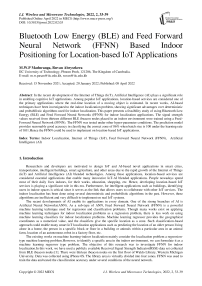Bluetooth Low Energy (BLE) and Feed Forward Neural Network (FFNN) Based Indoor Positioning for Location-based IoT Applications
Автор: M.W.P. Maduranga, Ruvan Abeysekera
Журнал: International Journal of Wireless and Microwave Technologies @ijwmt
Статья в выпуске: 2 Vol.12, 2022 года.
Бесплатный доступ
In the recent development of the Internet of Things (IoT), Artificial Intelligence (AI) plays a significant role in enabling cognitive IoT applications. Among popular IoT applications, location-based services are considered one of the primary applications where the real-time location of a moving object is estimated. In recent works, AI-based techniques have been investigated to the indoor localization problem, showing significant advantages over deterministic and probabilistic algorithms used for indoor localization. This paper presents a feasibility study of using Bluetooth Low Energy (BLE) and Feed Forward Neural Networks (FFNN) for indoor localization applications. The signal strength values received from thirteen different BLE ibeacon nodes placed in an indoor environment were trained using a Feed-Forward Neural Network (FFNN). The FFNN was tested under other hyper-parameter conditions. The prediction model provides reasonably good accuracy in classifying the correct zone of 86% when batch size is 100 under the learning rate of 0.01.Hence the FFNN could be used to implement on location-based IoT applications.
Indoor Localization, Internet of Things (IoT), Feed Forward Neural Network (FFNN), Artificial Intelligence (AI)
Короткий адрес: https://sciup.org/15018390
IDR: 15018390 | DOI: 10.5815/ijwmt.2022.02.03
Список литературы Bluetooth Low Energy (BLE) and Feed Forward Neural Network (FFNN) Based Indoor Positioning for Location-based IoT Applications
- M. Mohammadi and A. Al-Fuqaha, "Enabling Cognitive Smart Cities Using Big Data and Machine Learning: Approaches and Challenges," in IEEE Communications Magazine, vol. 56, no. 2, pp. 94-101, Feb. 2018.
- M W P Maduranga and Ruvan Abeysekara. "Supervised Machine Learning for RSSI based Indoor Localization in IoT Applications." International Journal of Computer Applications 183(3):, May 2021, pp 26-32
- M.W.P Maduranga, Dasuni Ganepola and R.P.S. Kathriarachchi "Comparison of Trilateration and Supervised Learning Techniques for BLE Based Indoor Localization" In Proc. of KDU-14th International Research Conference, Sri Lanka, 2021
- A. Gadhgadhi, Y. HachaΪchi, and H. Zairi, "A Machine Learning-based Indoor Localization," 2020 4th International Conference on Advanced Systems and Emergent Technologies (IC_ASET), 2020, pp. 33-38, DOI: 10.1109/IC_ASET49463.2020.9318284.
- P. Sthapit, H. Gang and J. Pyun, "Bluetooth Based Indoor Positioning Using Machine Learning Algorithms," 2018 IEEE International Conference on Consumer Electronics - Asia (ICCE-Asia), 2018, pp. 206-212, DOI: 10.1109/ICCE-ASIA.2018.8552138.
- Y. S. P. Weerasinghe, M. W. P. Maduranga and M. B. Dissanayake, "RSSI and Feed Forward Neural Network (FFNN) Based Indoor Localization in WSN," 2019 National Information Technology Conference (NITC), 2019, pp. 35-40,
- M.W.P Maduranga, Ruvan Abeysekera, "TreeLoc: An Ensemble Learning-based Approach for Range Based Indoor Localization," International Journal of Wireless and Microwave Technologies(IJWMT), Vol.11, No.5, pp. 18-25, 2021.DOI:10.5815/ijwmt.2021.05.03.
- M. W. P. Maduraga and R. Abeysekara, "Comparison of supervised learning-based indoor localization techniques for smart building applications," 2021 International Research Conference on Smart Computing and Systems Engineering (SCSE), 2021, pp. 145-148, DOI: 10.1109/SCSE53661.2021.9568311.
- S. Sadowski and P. Spachos, "RSSI-Based Indoor Localization With the Internet of Things," in IEEE Access, vol. 6, pp. 30149-30161, 2018, DOI: 10.1109/ACCESS.2018.2843325.
- Akshay Kumar H and Y. Suresh, "Multilayer feed-forward neural network to predict the speed of wind," 2016 International Conference on Computation System and Information Technology for Sustainable Solutions (CSITSS), 2016, pp. 285-290,
- X. Liu, J. Zhou, and H. Qian, "Comparison and Evaluation of Activation Functions in Term of Gradient Instability in Deep Neural Networks," 2019 Chinese Control And Decision Conference (CCDC), 2019, pp. 3966-3971
- X. Song et al., "A Novel Convolutional Neural Network Based Indoor Localization Framework With Wi-Fi Fingerprinting," in IEEE Access, vol. 7, pp. 110698-110709, 2019, DOI: 10.1109/ACCESS.2019.
- C. Hsieh, J. Chen and B. Nien, "Deep Learning-Based Indoor Localization Using Received Signal Strength and Channel State Information," in IEEE Access, vol. 7, pp. 33256-33267, 2019, DOI: 10.1109/ACCESS.2019.2903487.
- K. Jaafar, N. Ismail, M. Tajjudin, R. Adnan and M. H. F. Rahiman, "Z-score and feed-forward neural network (FFNN) for flood modeling at Kuala Krai Station," 2016 7th IEEE Control and System Graduate Research Colloquium (ICSGRC), 2016, pp. 92-97, DOI: 10.1109/ICSGRC.2016.7813308.
- P. R. Hajare and N. G. Bawane, "Feed Forward Neural Network Optimization by Particle Swarm Intelligence," 2015 7th International Conference on Emerging Trends in Engineering & Technology (ICETET), 2015, pp. 40-45, DOI: 10.1109/ICETET.2015.46.
- J. Huang et al., "A Big Data Enabled Channel Model for 5G Wireless Communication Systems," in IEEE Transactions on Big Data, vol. 6, no. 2, pp. 211-222, 1 June 2020, DOI: 10.1109/TBDATA.2018.2884489.


